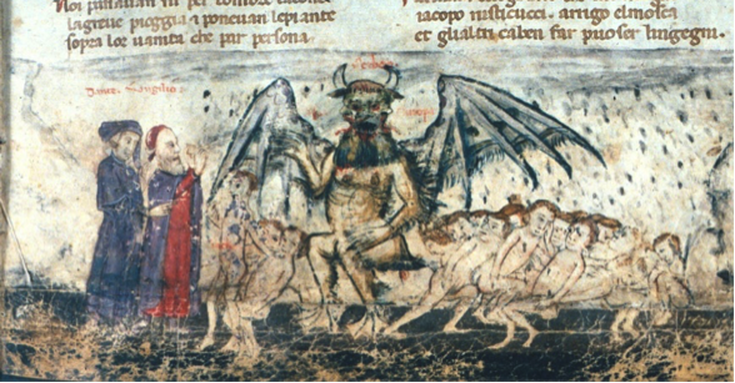|
Dr. Martin Bauch, Deutsches historisches Institut in Rom. I am in the third circle, filled with cold, unending, heavy, and accursed rain; its measure and its kind are never changed. Gross hailstones, water gray with filth, and snow come streaking down across the shadowed air; the earth, as it receives that shower, stinks. - Dante, Inferno, Canto VI In the last years of his life, Dante Alighieri (1265-1321) was an unsuspecting witness to a rapid shift in climatic conditions that led to cooler and wetter weather all over the continent. Perhaps it was not by chance that in his Inferno, finished in 1314, the sinners guilty of gluttony and sent to the third circle of hell were punished by incessant cold rain, hail and snow, while squirming through foul-smelling mud that reminded contemporaries of the crops rotting on their fields. Across Europe, meteorological events in the 1310s caused harvest failures, floods, famines, and mass deaths. In particular, Dante’s description of the wet third ring of hell is very similar to weather conditions that caused famine in Italy between 1310-12, and offers a prominent clue the onset of the Little Ice Age left in Europe’s cultural heritage.
Other traces of the cold, wet years appear in variety of sources: inscriptions from Central Europe which recall the thousands of starved individuals buried outside the city walls, and countless chronicles reporting death, famine, corpses on the streets, and riots linked to rising food prices. The hostile weather and massive soil erosion can also be reconstructed using scientific methods: ice cores from Alpine glaciers, sediment cores from lakes, and tree rings all reveal the rainy years that oaks all over Europe enjoyed, as these trees thrive on chilly and humid weather. Using these tools, scientists and climate historians have come to agree that climatic conditions changed seriously at the beginning of the 14th century, ending the presumed milder conditions of the so-called Medieval Climatic Anomaly and initiating the so-called Little Ice Age. When referring to the extreme wet and cool conditions in Northwestern Europe that were responsible for the Great Famine (1315-21), written sources and dendrochronological data agree that the 1310s were a decade of climatic stress. The damage of this decade, called the Dantean Anomaly by, was long thought to be restricted to the British Isles, Northern France, the Benelux countries and Northern Germany. But as not only the Inferno’s vision of hell indicates, the cool period was probably a trans-continental event.
64 Comments
|
Archives
August 2021
Categories |


 RSS Feed
RSS Feed